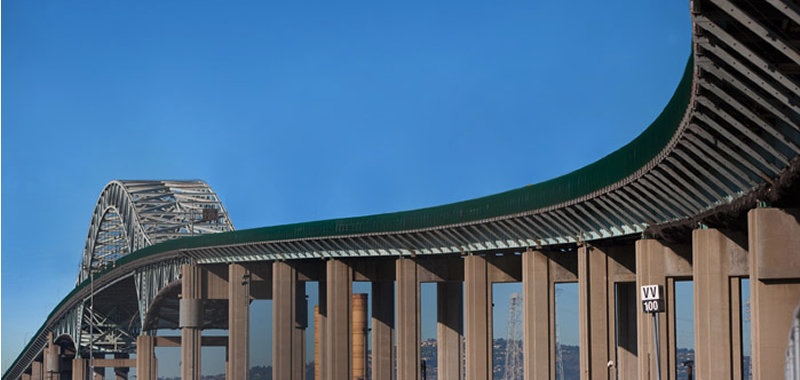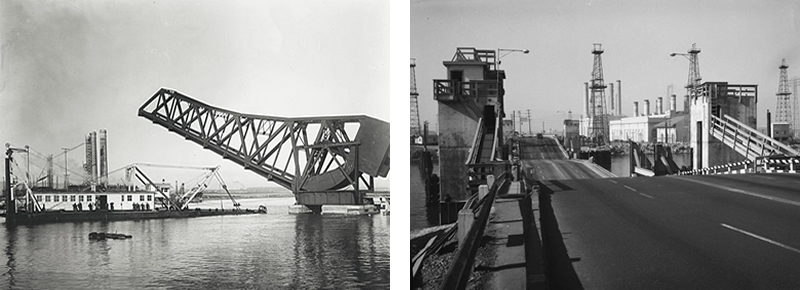HISTORY OF BRIDGE PROJECT
Covering the history of the bridge from the early 1900s.

Since its earliest days, Long Beach has needed reliable access to Terminal Island. The first bridge with access to the island was a single railroad track built on a wooden trestle by the Salt Lake Railway. By 1908, it was clear that something more reliable was needed. That year the trestle was replaced by a 187-foot bascule drawbridge known as the “jackknife” bridge, because it opened and closed like a pocket knife.
In the mid-1930s, the jackknife bridge was removed after the Union Pacific stopped using it. For several years, there was no bridge in place, leaving the Badger Avenue Bridge (now the Henry Ford Bridge) as the only rail link to Terminal Island.
As World War II neared, the Navy needed better access to and from its station on Terminal Island. A pontoon bridge was constructed that could open and close allowing ship traffic to pass in and out of the harbor. The pontoon bridge was intended to be a temporary structure in place for six months, but was used for decades.

In the mid-1960s, construction began on the replacement of the pontoon bridge, the Gerald Desmond Bridge. The roughly 1.5-mile span, named after a former city attorney and councilman of the City of Long Beach, was completed in 1968. The bridge has served the needs of the Port and the City for many years. Increasing traffic volumes and the ravages of time have taken a toll. Although safe for traffic, protective netting catches chunks of concrete that periodically fall from the span.
The Gerald Desmond Bridge has three lanes on the incline, and two lanes on the decline, in each direction. The new bridge accommodates three lanes of traffic in both directions, and includes four safety lanes to mitigate delays from breakdowns and accidents and give emergency vehicles better access. In addition, once the former bridge is demolished, clearance over the channel will rise from the current 155 feet to 205 feet, allowing larger, greener ships to enter the Port.
Gerald Desmond Bridge Replacement Project Timeline
Early 1990s: A replacement to the Gerald Desmond Bridge was first considered as maintenance costs continue to be incurred and the bridge will soon reach its original lifespan.
July 2008: The Port of Long Beach’s initially estimates a bridge replacement project to be about $950 million.
May 2009: The Harbor Commission allocated $26.4 million to develop plans for the bridge replacement project.
Feb. 3, 2010: The Port of Long Beach releases the draft environmental impact report.
Aug. 9, 2010: The Harbor Commission adopts the final EIR.
Nov. 3, 2010: The California Transportation Commission approved the Gerald Desmond Bridge Replacement Project as a design-build process.
March 2011: Four design-build contractor teams were approved to bid on the bridge replacement project.
July 2012: The Harbor Commission approved a contract with the SFI joint venture design-build team (Shimmick Construction Co. Inc., FCC Construcción S.A. and Impregilo S.p.A).
Jan. 8, 2013: The Gerald Desmond Bridge Replacement Project got under way with an official groundbreaking ceremony.
Oct. 1, 2014: Foundations of the Future event commemorates the start of construction on the Bridge Project foundations – more than 350 massive concrete pilings.
April 2016: The orange Movable Scaffolding System (MSS) begins construction on the westbound decline.
August 2017: Westbound decline completed by orange Movable Scaffolding System (MSS).
Dec. 5, 2017: Official topping-out ceremony commemorates the completion of the two 515-foot-high towers, the tallest structures on the Bridge Project.
Dec. 2017: Westbound incline completed by blue Movable Scaffolding System (MSS).
Oct. 5, 2020: The new bridge opens to traffic.
Dec. 14, 2020: Multicolored LED lights on the towers and cables are illuminated for the first time.
July 9, 2022: Main span of Gerald Desmond Bridge is lowered onto a barge for recycling as demolition work begins.
Aug. 24, 2022: The state Legislature makes the name official: Long Beach International Gateway Bridge.